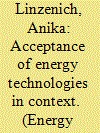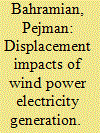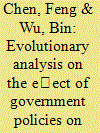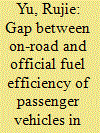|
|
|
Sort Order |
|
|
|
Items / Page
|
|
|
|
|
|
|
| Srl | Item |
| 1 |
ID:
180859


|
|
|
|
|
| Summary/Abstract |
In Carbon Capture and Utilization (CCU), CO2 captured from industrial processes replaces fossil feedstock used to produce of a variety of products, e.g., plastic products, fuels, or minerals. The roll-out of CCU will depend on the public's acceptance and risk perception. Whereas past studies exclusively focused on CCU risk perception, this study (n = 266) compared CCU to seven other infrastructure technologies (fossil, nuclear, renewable energies) to put the perceived CCU risks into perspective.
|
|
|
|
|
|
|
|
|
|
|
|
|
|
|
|
| 2 |
ID:
180856


|
|
|
|
|
| Summary/Abstract |
The energy transition that is developing across the United States is producing both winners and losers. While some individuals, households and communities are reaping the benefits of the move toward cleaner, renewable sources of energy, others are experiencing its adverse effects, such as disruptions to labor markets, higher energy prices, and pollution and health burdens. To address these disparities, policymakers are increasingly calling for energy justice. However, there is scant scholarly literature on either the prevalence or characteristics of energy justice programs that already exist. Here we show that energy justice programs are both quite widespread and diverse across the United States, are most often led by nonprofit organizations rather than government agencies, and, while many share common missions, programs entail unique and often innovative strategies to achieve their objectives. The analysis lends important insights into current energy justice programs, but we argue deeper evaluation is necessary to identify which efforts are efficacious.
|
|
|
|
|
|
|
|
|
|
|
|
|
|
|
|
| 3 |
ID:
180866


|
|
|
|
|
| Summary/Abstract |
Natural gas considers as the fuel for the 21st century and is expected to play an important role in the developing countries' energy mix due to clean fuel, environmental, climate goals and sustainability issues. India too is striving for increasing the natural gas share from 6.2% in 2019 to 15% by 2030. Government of India is also stressing to boost natural gas share in the country's energy mix, which is still below the desired level and presence of the barriers makes it difficult to establish natural gas as preferred fuel in this country. Therefore, it is imperative to analyze the criticality of the barriers to understand how they impact on the natural gas market of India. The study employs a two-phase methodology to identify and analyze the critical barriers restricting the natural gas demand in India by employing novel hybrid best-worst method (BWM). The results indicate that operational and supply related barriers are the two most critical out of the identified categories. The findings of the developed framework could be used by the policymakers, strategists and the managers, which will help them to reduce and eliminate the barriers and promote natural gas as the preferred fuel.
|
|
|
|
|
|
|
|
|
|
|
|
|
|
|
|
| 4 |
ID:
180860


|
|
|
|
|
| Summary/Abstract |
This paper explores the history of wind power technologies and the integration of wind energy in the Danish energy system. It does so focusing particularly on historical events, socio-cultural and socio-political changes and priorities that were important on this technological journey. From the first primitive wind turbines in the late 1800s, to the world wars, through the energy- crisis in the 70s, and into the decades of growing environmental awareness and concern, this historical account describes how policy priorities in Denmark gradually translated from the focus on energy diversification, energy efficiency and energy independence to the focus on sustainability and renewable energy resources, with wind energy and wind power technologies at the top of the priority list. Historically, wind power has been - and it still is - popular in Denmark. However, as the modern wind power turbines gradually grew to industrial scale heights, unchallenged support for specific local wind farms could no longer be taken for granted. This paper also touches upon the frequently tacit dilemmas of renewable energy technology planning and deployment, for example issues of environmental justice, wind farm ownership structures, and the role of social psychology for low-carbon energy transition processes. Notably, attention is drawn to the representation biases that may result in the emphasis of wind farm opposition / grievances in the wider wind farm related debates, where resistance to local wind farm projects might derive from minority opposition groups. Insights and lessons learnt from this Danish history of wind power may prove valuable and inspirational for other countries engaging in low-carbon energy transitions.
|
|
|
|
|
|
|
|
|
|
|
|
|
|
|
|
| 5 |
ID:
180858


|
|
|
|
|
| Summary/Abstract |
Renewable portfolio standards (RPS) is an institutional change from Feed-in Tariff (FIT) to government policy and market mechanism. Is it conducive to improve China's social welfare? Given this problem, this paper constructs the social welfare function under the FIT policy and RPS system respectively based on consumer heterogeneity and simulates the social welfare of China under the two schemes on the basis of combining the real economic situation of China. The results show that: (1) Based on China's real economic situation, the implementation of RPS has achieved Pareto improvement and improves China's social welfare. (2) Under the RPS, compared with the actual situation of oligopoly in China's electricity market, competition can improve social welfare better. (3) The effective implementation of RPS depends on the quota level of the government's scientific design. As far as China's current real economic situation is concerned, when the quota is set in the interval (0,0.5], the social welfare under the RPS is always higher than that under the FIT. Therefore, to improve social welfare and promote low-carbon energy transition, China should effectively promote the implementation of RPS, a mandatory institutional change, and strengthen the system construction of RPS.
|
|
|
|
|
|
|
|
|
|
|
|
|
|
|
|
| 6 |
ID:
180861


|
|
|
|
|
| Summary/Abstract |
To improve the air quality in winter, clean heating policy was implemented in “2 + 26” cities of China in 2016, which mainly included replacing coal with gas or electricity. Tremendous financial subsidies have been provided by city and central governments. This new heating mode changed the heating fee-cost to residents. This paper estimates the economic costs to both governments and residents, and evaluates the environmental and public health benefits by combining a difference-in-differences model with an exposure-response function. Results show that the total costs of clean heating were up to 43.1 billion yuan. Governments and residents account for 44% and 56% of the total costs, respectively. In terms of benefits, the clean heating project is effective for air pollution control and brings health economic benefits of about 109.85 billion yuan (95% CI: 22.40–159.83). The clean heating policy was identified as a net-positive benefit program with environmental and public health improvements. However, the inequality in subsidies from different cities governments increases the heating burden on low-income households and leads to heating poverty for households in the less developed regions. We provide suggestions for implementation in future clean heating campaigns and in subsidy mechanism design in China and for other developing countries.
|
|
|
|
|
|
|
|
|
|
|
|
|
|
|
|
| 7 |
ID:
180864


|
|
|
|
|
| Summary/Abstract |
In several countries, electricity systems are under strong decarbonization pressure. In particular, the Canadian provinces of Quebec and Ontario as well as the states of the northeastern United States have committed to cut their greenhouse emissions by more than 70% (with respect to emission levels of 1990). Increased collaboration and integration between jurisdictions could decrease such decarbonization costs, especially when important hydropower resources are available.
|
|
|
|
|
|
|
|
|
|
|
|
|
|
|
|
| 8 |
ID:
180865


|
|
|
|
|
| Summary/Abstract |
In several countries, electricity systems are under strong decarbonization pressure. In particular, the Canadian provinces of Quebec and Ontario as well as the states of the northeastern United States have committed to cut their greenhouse emissions by more than 70% (with respect to emission levels of 1990). Increased collaboration and integration between jurisdictions could decrease such decarbonization costs, especially when important hydropower resources are available.
|
|
|
|
|
|
|
|
|
|
|
|
|
|
|
|
| 9 |
ID:
180868


|
|
|
|
|
| Summary/Abstract |
Increasing variable renewable energy penetration, climate change, and global uncertainties will make it harder to stabilize and balance power systems. This situation will be especially challenging for developing economies with limited capital and institutional capacity, poor infrastructure, and rapid economic growth. Using the Philippines as a case study for a developing economy, the paper identified chronic underinvestment in the supply of ancillary services that play a crucial role in balancing energy supply with demand and building grid resilience. To diagnose the cause, the paper created a novel dataset with all ancillary services revenue contracts in effect at the end of 2019 and analyzed their key terms and conditions. The paper concludes that these contracts are not conducive to financing due to short durations, low and soft buying commitments, exclusive focus on incumbent versus new entrants, hour and season constraints, and a poorly implemented remuneration methodology. The literature rarely analysis this topic from a financing perspective and at this level of detail. Revenue contracts need to switch to long-term, firm, and technology-specific cost recovery mechanisms with new entrants, to incentivize financing. Storage technologies such as batteries and hydropower should be prioritized, followed by gas turbines. These changes will result in a more secure, resilient, and affordable power system.
|
|
|
|
|
|
|
|
|
|
|
|
|
|
|
|
| 10 |
ID:
180840


|
|
|
|
|
| Summary/Abstract |
The new potential of Distributed Energy Resources (DER), residential consumers, buildings, and prosumers in terms of controllable devices, self-generation, and storage makes them more active in the market encouraged by lower electricity prices. In addition, integrating a higher volume of volatile Renewable Energy Sources (RES) that unstress the public grid by local trading interactions is a desirable target of Local Electricity Markets (LEM). In this paper, we propose a blockchain trading mechanism to simulate the electricity transactions for 11 modern smart houses with more than 300 appliances, 8 roof- or faced-PV systems, and smart-metered 15-min readings that form a small-size community. The electricity generated at the community level lowers the electricity bills and brings benefits for prosumers (sellers) and consumers (buyers). Several trading mechanisms for LEM transactions including auctions such as Uniform Price (UP), Pay-As-Bid (PAB), Generalized Second-Price (GSP), Vickrey-Clark-Groves (VCG) methods are implemented to evaluate the benefits and show their efficiency. After the market is initially cleared, an adjustment coefficient of the price is proposed for both sides (seller and buyer) to enlarge the trading potential at the community level using blockchain technology. It proves to bring excellent results to the LEM participants and enhance trading with outstanding benefits.
|
|
|
|
|
|
|
|
|
|
|
|
|
|
|
|
| 11 |
ID:
180846


|
|
|
|
|
| Summary/Abstract |
The displacement impacts of wind power generation on other generation technologies are estimated for Ontario. In addition, their annual financial benefits, costs, and international stakeholder impacts are measured. For every 100 MWh generated, almost 53 MWh of gas output is displaced, and 19 MWh of power is exported. Due to inadequate storage capacity hydro power generation is reduced by 23 MWh. Ontario on average loses about 859 million USD annually from having wind power generation in the system, while the US gains approximately 10 million USD through electricity exported from Ontario. Wind power generation has produced an estimated 109 million USD of benefits by reducing CO2 emissions in the US and Ontario through displacing thermal generation. Comparing the environmental benefits with the net cost to consumers shows the promotion of wind power generation to be largely a waste of Ontario's resources.
|
|
|
|
|
|
|
|
|
|
|
|
|
|
|
|
| 12 |
ID:
180857


|
|
|
|
|
| Summary/Abstract |
With the rise in cooling demand and the permeation of decentralised renewable energy resources in electricity networks, electricity demand-side management (DSM) has become a major tool for electricity planning and decarbonisation in the Global South. In India, the commercial application of DSM is not new, yet utility-driven residential-scale demand response (DR) remains an unexplored area. This paper contributes on two fronts – to explicate householders and practitioner's perceptions of DR: disjunctions between these perceptions and its implications for the acceptance of residential DR. Using a co-production approach, this paper draws insights from two sets of stakeholders in India - 25 DR policy and utility experts and 24 household consumers. Our results show that technological saviourism pervasively underscores practitioners understanding of DR and householder agency, a crucial factor in the adoption of DR at the residential scale remains a missing piece. The paper concludes that without considering householder agency, delivering a decarbonised future based on demand response will be challenging and consumers may remain locked into-existing socio-cultural practices that negate the adoption of DR.
|
|
|
|
|
|
|
|
|
|
|
|
|
|
|
|
| 13 |
ID:
180849


|
|
|
|
|
| Summary/Abstract |
In developing countries, the penetration of Liquefied Petroleum Gas (LPG) is still high, and hence the entry of Natural Gas (NG) networks coexists with the use of LPG by an important fraction of households. A relevant policy question is whether the degree of horizontal integration between NG and LPG providers has an influence on the level of retail prices. Using self-reported retail prices of the largest LPG provider in Chile during years 2013 and 2014, we estimate that the presence of a competing NG network generates an average decrease of LPG retail prices within the range [-4%,-2%]. This result suggests that the degree of horizontal integration between NG and LPG providers should matter, in particular for policy interventions such as merger control by competition authorities and the granting of concessions for deploying NG networks by sectoral regulators.
|
|
|
|
|
|
|
|
|
|
|
|
|
|
|
|
| 14 |
ID:
180862


|
|
|
|
|
| Summary/Abstract |
To solve the different environmental problems caused by the over-use of fossil fuels, multiple environmental policies currently coexist. How these environmental policies interact with each other and how to optimise them are a few issues that need to be resolved urgently in practice. We established an environmental dynamic stochastic general equilibrium model (E-DSGE) to analyse the dynamic interactive effects of the SO2 emission tax and CO2 emission trading in China and the optimal design of these two environmental policies. We have calibrated the model based on China's actual data. The results indicate that synergistic emission reduction effects have led to an overlap between the two policies, because both SO2 and CO2 emissions share a common root—fossil fuels. Currently there is no obvious conflict between them. When the SO2 emission tax is levied at 12.6 CNY/kg, the CO2 emission cap should be lower than 76.1%. Second, the synergistic emission reduction effect between CO2 emission trading and the SO2 emission tax can enhance the automatic stabilisation function of both. Third, we suggest to optimise both policies pro-cyclically. However, if either of these two policies is ineffective, the optimal SO2 emission tax will be counter-rather than pro-cyclical.
|
|
|
|
|
|
|
|
|
|
|
|
|
|
|
|
| 15 |
ID:
180855


|
|
|
|
|
| Summary/Abstract |
New societal trends are unfolding, such as digitalization, sharing economy and consumer awareness. They will highly influence future energy demand and, depending on their realization, enhance or counteract projected energy efficiency gains. Therefore, these trends have to be accompanied by policies with a strong focus on reducing energy demand (including Energy Efficiency First). This work analyzes quantitatively for all sectors how New Societal Trends interact with energy efficiency (policies).
|
|
|
|
|
|
|
|
|
|
|
|
|
|
|
|
| 16 |
ID:
180854


|
|
|
|
|
| Summary/Abstract |
This work explores the consequences that different energy poverty definitions and measures might have for the identification of the energy poor. Using the 2017 National Survey of Public Energy Perception applied to a sample of 3,500 households in Chile, we compare the respective identification outcomes of applying the ten percent rule index (TPRI) and our proposed Perception-based Multidimensional Energy Poverty Index (PMEPI) against the monetary poverty identification outcome. Based on the findings of this comparation, we propose a classification system of first- and second-order energy poverty measures depending on their degree of association with income poverty (as indicated by the distribution of the income poverty status of households). A first-order energy poverty measure exhibits a high association level with income poverty. By contrast, a second-order energy poverty measure shows a low level of association. Coincidentally, our TPRI (first-order) and PMEPI (second-order) estimates each classify 15.5% of the population as energy poor. However, the adoption of any particular definition necessarily narrows the resulting set of energy-poor households in a way that is distinct from other definitions, meaning that the use of multiple definitions produces diverging energy poverty rankings across the territory. Moreover, the TPRI neglects supply-side constraints captured by the PMEPI. Consequently, when identifying and targeting the energy poor, first- and second-order definitions should not be used as substitutes but rather as complements. This fact needs to be considered in the energy policy debate on the implementation of energy poverty alleviation actions.
|
|
|
|
|
|
|
|
|
|
|
|
|
|
|
|
| 17 |
ID:
180853


|
|
|
|
|
| Summary/Abstract |
Many countries have implemented incentive policies to support green R & D. However, the behavior of enterprises using the information asymmetry between government and enterprises to camouflage green R & D and obtain preferential policies will lead to the failure of policies. In order to explore the effectiveness of policies in stimulating green R & D, this paper studies the diffusion of green R & D in the photovoltaic industry under different scenarios of incentives and supervision. The results show that: (1) improving regulatory capacity or punishment can inhibit the behavior of enterprises camouflage as green R & D. (2) Under current policies, R & D tax incentives increasing has no obvious effect on the diffusion of green R & D. (3) When implementing the green R & D quota system (GRDQS), the diffusion of green R & D can be deduced under model, even if the R & D tax preference is cancelled. Based on our model, we believe that the GRDQS is an effective means to encourage the photovoltaic industry to carry out green R & D.
|
|
|
|
|
|
|
|
|
|
|
|
|
|
|
|
| 18 |
ID:
180841


|
|
|
|
|
| Summary/Abstract |
The gap between on-road fuel efficiency and official fuel efficiency of passenger vehicles reported by manufacturers is widening, which would lead to the underestimate of real fuel consumption and biased projection of energy demand in the road transport sector. To investigate the gap between official and on-road fuel efficiency of passenger vehicles, we first built a comprehensive dataset of 393,108 valid observations, including vehicle system parameters, fuel-efficient technology, etc. Then we developed two regression models to quantify the driving factors of the increasing gap and slow improvement in on-road fuel efficiency, and the contribution of each factor to the gap. Results show that the fuel efficiency gap enlarged from 14.4% in 2010 to 25.1% in 2016, and the average on-road fuel efficiency did not have substantial improvement though the official fuel efficiency did. The fuel-efficient technologies have the greatest effect on both the fuel efficiency gap and on-road fuel efficiency among the factors considered in this study. Among the fuel-efficient technologies, hybrid electric vehicle would decrease the ratio of on-road to official fuel efficiency by 12.4% and improve the on-road fuel efficiency by 44.1%. Impacts of other fuel-efficient technologies were also assessed. Further government effort on policies to encourage fuel-efficient technologies for improving real on-road fuel efficiency is needed.
|
|
|
|
|
|
|
|
|
|
|
|
|
|
|
|
| 19 |
ID:
180847


|
|
|
|
|
| Summary/Abstract |
The recent rise of auctions to allocate support payments for renewable energy projects creates new uncertainties during project development and causes a decrease in support levels. We investigate the effects of the shift to auctioning on costs of capital (CoC) and financing conditions through semi-structured and focus group interviews with 40 experts in onshore and offshore wind project development and financing in Europe. We find that auctions create a competitive environment that pressures the industry into accepting higher risks and lower returns. Banks have reduced debt margins, while large investors decreased hurdle rates and equity returns, despite additional risks from auctions, such as uncertainty about future award prices, allocation and qualification risks. The risk of being awarded support and incurring sunk costs makes smaller bidders averse to participating in auctions. Competitive bidding may also decrease secured revenues and increase offtaker risks, especially when combined with sliding premiums. Despite increased price risk, the competitive pressure driven by project sponsors, seems to lower financing costs and hurdle rates, thus decreasing CoC for offshore projects. To reduce negative impacts on CoC and financing, policymakers can minimise additional risks, by adopting remuneration schemes that stabilise revenues, and supporting smaller actors through removing participation hurdles.
|
|
|
|
|
|
|
|
|
|
|
|
|
|
|
|
| 20 |
ID:
180842


|
|
|
|
|
| Summary/Abstract |
High energy and material demand in the building sector causes large greenhouse gas (GHG) emissions. This sector needs large-scale technological improvements in the transition to a future low-emission society. Extensive research is carried out on highly energy-efficient and zero emission buildings (ZEB), but the new technologies slowly penetrate the market. Until now, no bottom-up studies have applied a dynamic building stock energy model at the national level to quantify effects of a large-scale ZEB introduction. Using the RE-BUILDS 2.0 model, we explore and extensively discuss the aggregated potential for energy and GHG emission savings in the Norwegian building stock towards 2050. A Baseline scenario is compared with two ZEB scenarios assuming introduction of the ZEB definition and ZEB technologies applied in the future new built and renovated buildings, with an increased ambition level over time. The results reveal a large potential for energy and GHG emission savings of ZEB deployment towards 2050. Hence, stricter future regulations and practice will have important aggregated effects. Due to the long lifetime of buildings and potential lock-in effects, it is urgent that ZEB policies are implemented if the climate change mitigation potential of the Norwegian building stock is going to be reached.
|
|
|
|
|
|
|
|
|
|
|
|
|
|
|
|
|
|
|
|
|